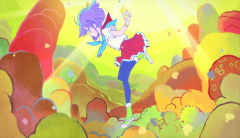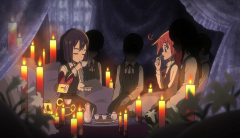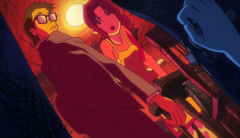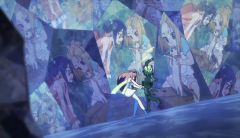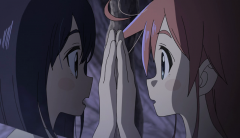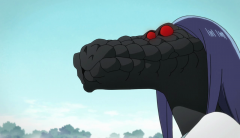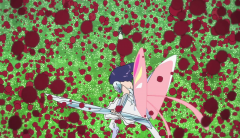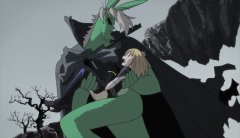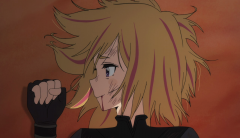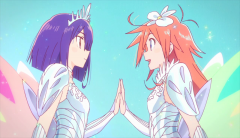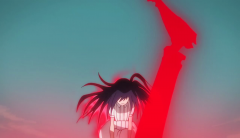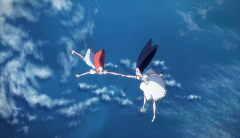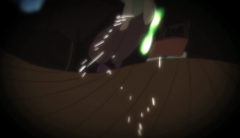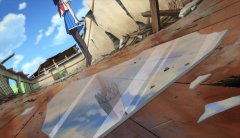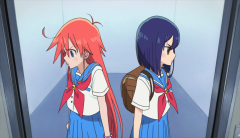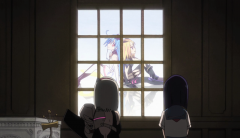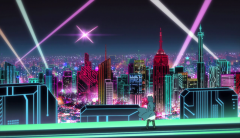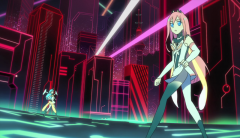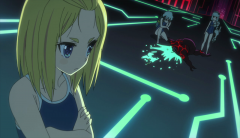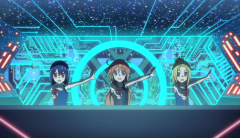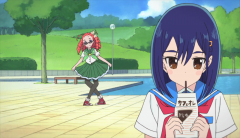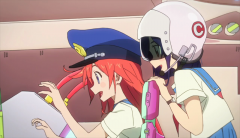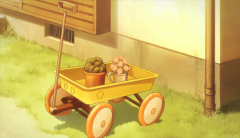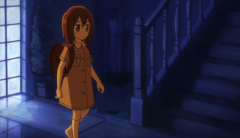What makes Flip Flappers stand out from the rest of the anime field? I found a lot of people asking that question along the way. Well, first off, Flip Flappers isn’t your ordinary anime offering, that’s for sure. Its visual styles are too much and too incoherent for one thing, the narrative never really reveal anything until halfway point for another thing. At the same times, this is the one rare anime that inspired many analysis, essays trying to decode what it is actually about, drawing thematic relevance out of their visual motifs and symbolism. So, what’s all the fuss, really? Let me get into that now.
On the surface, Flip Flappers is an adventure stories between the timid, shy Cocona who was dragged by the impulsive Papika into “Pure Illusions” worlds, the alternative realities that might or might not represent the inner psyche of its human’s subjects; to collect fragments that would grant wishes. Originally billed as a magical girl, the show hops through variations of genre, settings to whatever it pleases. In one episode Papika and Cocona were in the middle of a wasteland for an action Mad Max-inspired adventure, to the next they were trapped in a Class-S circle that would actually surpass many psychological horror shows out there, to another episode where they mysteriously became one identity that would make any David Lynch’s fans proud. It’s that freedom to break the rules and pick whatever content and styles they see fit made the show refreshing and unpredictably, which actually very fitting to how adventures should be like.
Moreover, Flip Flappers is a very visually arresting show, a true “show, don’t tell” kind of series. We’re no stranger with shows that are more about styles, shows that are showcases for young, talented animators to experiment with new styles and visuals, Normally, I don’t mind those kinds of show because we do need something like this to push the boundary of anime medium, but more often than not those shows don’t have any proper storytelling at all. Great visual doesn’t mean great storytelling anyway. Flip Flappers walks that very thin line as the show seemingly try to overwhelm us with its abstract visual, vibrant imaginary; color and resonant emotions in an expense for coherent plots; but I will give the show this: while Flip Flappers not always make sense narrative, it more than makes it up thematically as those wild visuals and motifs are in service for of its adolescence themes.
In fact, if you look a little deeper behind its fun adventures, the show constantly addresses many of its coming-of-age concerns throughout its run. First and foremost is the theme of identity, as for its 13-episodes long our main Cocona had to figure out who she wants to be, whom she can be trusted. The identity theme is continuously directed in many forms, both visually and symbolically: from Cocona being a constant source of being manipulated and controlled by others, those two girls are trapped in a false, repetitive cycle of “safe” environment, the girls represent the same character or even to other extreme, Papika appears continuously as various different identities. Papika and Cocona’s relationship, on the other hand, function like two sides of the same coins of being growing up. The show is a constant adolescent journeys that make up from opposing force between the urge, freedom and emotional directness from Papika and compassion, responsibility, think before act quality from Cocona. It’s a legitimate fear of growing up and becoming an adult filled with responsibility and burden; but as the third girl Yayaka and our Cocona later figure out, maybe small steps like be honest to your feeling could be what it takes to become a fully-grown person and overcome that fear.
The show’s climax, while closing down nicely Cocona and Papika’s relationship and give Mimi just about enough development to become a fearsome antagonist; I still consider it a lackluster final arc that keep me from giving it a higher score, especially coming straight from a spectacular middle part. In fact, the only time I would consider as brilliant in this last arc was Yayaka kicks ass and getting a well-deserved transformation. The rest of the cast unfortunately don’t have much roles in the final showdown. Judging those side characters as a whole, we actually know very little about them despite the twins and the staffs from Flip Flap organization appear in nearly every single episode, which is a shame. The late addition of Nyunnyun and the very role of Bu-Chan are also hugely unnecessary, as they don’t add much to the big picture and moreover, the inclusion of them feel a bit awkward to the rest of the story. Dr. Salt, on the other hand, had a bit of development but the show still doesn’t know how to use him to full potential as his role in the show function towards Mimi only; as a result; although it’s pretty much confirmed that Dr. Salt is Cocona’s father, I have a hard time believing that because there was no chemistry between them. Maybe that’s a whole point as he felt awkward towards Cocona based from his guilt, but I have a feeling that the show doesn’t seem to try even that.
But as I said in my weekly post, judging the show by how well it plays the rule isn’t a right approach, for Flip Flappers is the show that determines to break free and walk its own path. So back to that very first question: What makes Flip Flappers special? Well, I will put it this way: the show is a sublime example of animation in its purest form. Shows like this further highlight what makes animation so unique and appealing (I’m not talking strictly about anime, but the whole animation medium) that others medium can’t be able to express. Story like this can only works in animation form and the show successfully remind us the pure magic of animation and really why we fall in love with animation in a first place. With show as confident and creative as this I have a pretty optimistic feeling for the future of animation. Cross my fingers.




